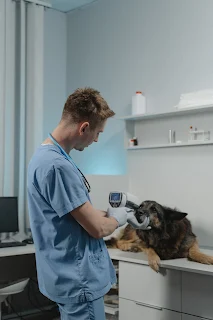Heat stroke is an extremely dangerous and scary experience. You feel dehydrated, have no idea what's going on, and above all, know something is wrong. In dogs, heatstroke can be fatal to humans and animals. It is important to ensure that this does not happen to pets. The first step is to know how to prevent it.
Dogs cannot sweat like humans and are more vulnerable to heat stroke. Dogs only pant to be cool, which is why you see dogs panting on hot days. Unfortunately, dogs cannot cool down in extreme conditions like humans and therefore require proper attention.
All responsible dog owners want to protect their dogs from the elements. Heat stroke is very unpleasant and bad if a dog gets heat stroke, even if it is reversible to an extent. Keep reading to find out what you need to know about dogs and heat stroke.
Signs and Symptoms of Heat Stroke in Dogs
As humans, we can cool down by taking deep breaths and sweating. Dogs don't sweat as much as humans, and they have a limited ability to cool down like humans.
Dogs need to cool down by panting. Panting passes air over their mouth and removes heat. Interestingly, the lining of a dog's lungs acts as a heat dissipation mechanism, and their face, ears, and feet have blood vessels that can dilate to dissipate heat outward and cool them.
- A dog's core temperature under normal conditions ranges from 100.2ºF (about 37.9ºC) to 102.8 degrees Fahrenheit (about 39.3ºC).
- If a dog's core temperature exceeds 104 degrees Fahrenheit (about 40ºC), the dog is in danger of developing serious health problems.
- If the dog's core temperature rises above 106 degrees Fahrenheit (about 41.1ºC), you will be very lucky if you manage to bring the temperature back down and keep the dog alive.
Heat Stress
Heat stress is essentially the line between baking and freezing or going overboard and potentially getting heatstroke.
The best way to deal with heat stress is to pay attention to your dog's behavior, whether or not they need to go to the bathroom. When you are familiar with your dog's behavior and symptoms, it becomes easier to know when they are experiencing the effects of heat. This may include, but is not limited to:
- lethargy
- Don't want to move
- Dig to create a cool space on the ground
- Drooling
- Obvious discomfort
- Excessive panting
Risks for Heat Stroke in Dogs
In addition to knowing when your dog is experiencing heat stroke, you also need to be aware of conditions that can cause problems that lead to heat stroke. If you live in a city, you know that summer heat is trapped in tall buildings and concrete.
Humidity worsens these effects, making the air very thick and difficult to breathe. Sidewalks also get very hot, burning a dog's paws and raising their body temperature. For this reason, avoid walking your dog on asphalt or concrete on hot days. Try to limit walking to early morning or in the evening time if possible.
Photo by Kampus Production: From Pexels.
Also, everyone has seen someone leave their dog in the car on a scorching day, by accident or otherwise. Anyone who has sat in a car parked all day at the beach or in an open space knows that it inevitably becomes a mini furnace, even if you keep the windows open to let in the fresh air. These conditions can give the dos heatstroke and can be fatal very quickly.
Predisposing Factors for Heat Stroke
Aside from factors and circumstances that dog owners can prevent, some dogs have genetic traits that make them more disposed to getting heat stroke. As such, these factors require you to be more careful. Once heat stroke occurs, it becomes easier for the dog to recover, as it becomes a predisposing factor.
Some of these factors are present in short-nosed (brachycephalic) dogs, as their airways inevitably require more force to inhale air than a long-nosed dog can. This makes these short-nosed dogs, such as pugs, boxers, and bulldogs, more susceptible to heat stroke. However, this does not mean that it cannot be stopped.
These smooth-faced breeds have nasal passages and mouths that are very close together, making it difficult to dissipate heat effectively.
Another predisposing factor is obesity and laziness. This makes it difficult for dogs to dissipate heat as their body structure holds it all in as if they were wrapped in a wool blanket. Excess body fat acts as an insulating layer and retains all heat, preventing it from freezing. The extra layer generates extra heat, and so the cycle repeats, increasing the likelihood of heatstroke.
Dogs breeds such as Labradors, Sheepdogs, German Shepherd, and Terriers may also be more susceptible to heat stroke because their more aggressive attitudes and behavior will lead them to play in areas where they are most prone to heat stroke. In this case, there is nothing genetically wrong, you just need to keep them in check.
- Young puppies: Their bodies are not yet fully developed.
- Old dogs: Strength in their body is decreasing.
- Dogs on certain medications: Some medications may increase the risk.
Dogs with pre-existing illnesses can also develop heat stroke more easily due to pre-existing complications.
FAQ?
How long does heat stroke last in dogs?
If a dog has heat stroke, it usually lasts five to seven days. You can counter the dog's body temperature and when heat stroke is reported by pouring cold, not cold, water on the dog and allowing him to excrete it so that the water does not warm to the same temperature.
Check the dog's temperature frequently until it comes to 103 degrees Fahrenheit (about 39.4 degrees Celsius). This process should take about 30 minutes to an hour. Do not try to quicken the dog by pouring large amounts of cold water on it, because if the dog's core temperature drops too quickly, you risk internal hypothermia and possibly death of your dog.









0 Comments